“It's the beginning of summer tonight and every season has cracks through which winter or fall might leak out. The most perfect flavor of it, oddly in June.”
by Eileen Myles, from “Holes” (collected in “I Must Be Living Twice, New & Selected Poems 1975-2014”)
01/07/2024, London, UK
My dear,
As I tuck myself behind my desk once more, I confess I haven’t written much this month— but would it please you to know I’ve done a lot? All things wonderful flock to me, you know. I’ve been on my socialite business, attending soirées and private art showings1 (don’t ask me how I got invited, I haven’t a clue), and I read my poetry out loud for the first time in front of an audience. June has been a month of blossoming, of perfectly cutting pomegranates, of relishing and revelling. Uncharacteristically for me, most of this past month I spent traveling, to Paris and the Swiss Alps, and that should strike you as unusual. Ask anybody that knows me: I am a homebody, I grow firm roots! So I suppose I was a bit subversive this month after all. All my icons are smiling at me from wherever they are.
Getting swept up in all of my explorative nonsense, forgive me for not really finding time to write a full-on bachelor thesis length research newsletter like usual. No, this fine June newsletter will be of much less consequence, a grab-bag of sorts. First of all, I wish to share some of my all-time tried and true articles and favourite academic papers with you, relating to no specific theme at all. Leftovers, if you will. But crucial nonetheless. Crucial in holding up all the other thoughts in my mind, supporting them like pillars of sorts. Then, a little bit of an informal Paris guide or diary, and some words and stories from the Swiss Alps. A little look at what I’ve been reading and watching and listening to, and where I’ve been so far this mild summer.
Before you start with me, you can leave your complaints about the temperate weather right at the subject line of this letter, because I am a fervent (and proud!) summer hater, and so the past June with its downpour, grey skies, and thunder have been like a balm to my usually sun-drained soul. Let me have this, please, and thank you. You are free to complain about winter when it rolls around again, don’t fret.
But first…
With this newsletter’s anniversary creeping right up, I have of course been preparing already to write a gargantuan, swollen, monstrous thesis of a newsletter to be delivered to you on August 1st. For this marvellous occasion, we shall revisit the theme of “Death and the Maiden”. It’s without a shadow of a doubt one of my absolute favourite tropes out there, and my hunger for it never decreases, therefore I wish to invite you to join in on the feast!
For the very first time, I would like to issue a descriptive prompt for all your fabulous submissions: in honour of our upcoming anniversary I invite you to ponder “Death and the Maiden” with me, and create whatever you see fit based on that. Photography, writings, poetry, essays, short stories, multi-media work— all is welcomed! Think about the tenderness of the Maiden, or the darkness of Death, the ways in which they meet and overlap. Wonder about Persephone and Hades, little red riding hood and the big bad wolf, vampire romance stories of all sorts, personifications of Death, or even queer media like “Killing Eve” or “Hannibal” which play with this dynamic in some ways. Loving the monster. You can also browse my Tumblr tag here to get an idea of the vibe. Submissions for this specific prompt close on July 26th2, so be sure to submit before that to be a part of the celebrations! You can find our submission guide here, as always.
Now, where were we? Oh, that’s right. Our usual round-up of the past month’s White Lily Society happenings. Let’s see, let’s see. We published another wonderful submission: a beautifully precise essay about the lines where pain and pleasure meet, and then on socials there was a short write-up about a metaphysical poem by Andrew Marvell, as well as another one of our rare periodical style guides on Spencer Hastings from “Pretty Little Liars” (2010-2017). Choosing quality over quantity, my dear.
Now, have you had your fill of the flavour text? Do you hunger for something more substantial yet? Your mind wanders? Alright, alright, don’t get too antsy. Let us move on then.
I. Archive Updates
“You think you are possessing me – / But I’ve got my teeth in you.”
by Angela Carter, from “Unicorn”, collected in “Unicorn: The Poetry of Angela Carter” (1966)


As promised, I have prepared you a veritable buffet of literature spanning a vast range of interests. Instead of the normal fully Romanticism / Gothicism focused efforts, two out of our three selected papers today are more “nerdy” in nature, that is they focus on media: film & tv, and video games. Of course, there is still a little Keats here for your freakish literature-lavished tastes, but my point is that I don’t often “get” the chance to luxuriate in my geekier interests in doing research for this newsletter— mainly because I don’t often find one topic “large enough” to fill an entire letter. Therefore, I’ve indulged a little today. I digress.
Coming right up, a starter of Keats, with a main of the tried and true “sex scenes in movies” debate, and video game monster design for dessert. Bon appetit.
“Hooted from the Stage” - link
This London Review of Books article about John Keats, although a bit lengthy, is a wonderful look at so many factors in his life, and how they found their way into his legendary poetry. Starting with a humorous look at Joseph Severn and his “photobombing” of Keats’ [after]life, and then moving onto Keats’ history, his hopes and dreams that end up infusing into his writing, onto the essential role that poetry fulfilled for him as something to live through and for, and ending with discussions of several biographies about Keats and Co. This is a thorough exploration of Keats psyche and his work, and one I enjoyed reading in bits and pieces over the course of several days. Paired with a cup of tea, of course.
“For Keats, this is what medicine ought to have been able to do but now is a task for poetry: the transformation of desire into embodiment, the animation of the inanimate, the restoration of the deathly to health, the bringing of stone or bone or art to warm life. We see an early, bewildered version of it as far back as Endymion, where a mortal in love with the immortal moon encounters a cavern full of long-frozen lovers and, by his mere arrival, restores them to life, an essentially Keatsian ekphrasis.”
“Everyone is beautiful and no one is horny” - link
Sort of fundamental text for me ever since I first read it, I like to pull out this article every time the whole “gratuitous sex scenes in media” discourse stirs up again on whatever social media it is this month. Talking about the increasingly absurd beauty standards in Hollywood, as well as the rise of a very specific Puritanism where everything has to be pure and sterile, to even military propaganda, this article offers a succinct but explorative look at why everybody is so beautiful in film and tv nowadays, and why they are also, decidedly devoid of any real passion for one another, instead overflowing with iron will and lame quippy one-liners. Bummer.
“On the surface, it is idyllic: racial harmony, gender equality, unity behind a common goal—and firm, perky asses and tits.
And then the characters speak. The topic of conversation? Military service, of course. […] No one looks at each other. No one flirts.
A room full of beautiful, bare bodies, and everyone is only horny for war.”
“Designing the Body: Female Monster Design in Video Games” - link
Somehow, someway, I stumbled onto a WIRED article about sexual dimorphism in World of Warcraft this month, and oddly fascinated, I went looking for the original source. Finding that one defunct, I instead found this research paper talking about the same phenomenon. Basically, why is it that the male and female of a [monster] species differ (“sexual dimorphism”) in video games in particular, and why do these differences very often follow our own societal gender norms? Why is the male monster ripped and big, and the female monster sexy and slender? How do these designs get accepted and how do they influence gamers’ perceptions of gender? This paper makes ample use of both Kristeva’s iconic work on abjection in horror, as well as Barbara' Creed’s work on the monstrous feminine in its brief examination of this trope, so it brings up some good evidence and examples to cast a light on this phenomenon. A very good place to dip your toes into this subject.
“Female characters are many and there are equally as many tropes assocated with them, but we can quickly get to a conclusion: Women must be softer and smaller, physically attractive to males, and so it means that they should fulfil typical roles in games that reflect what we have seen in other narratives and media: the healer, the damsel, the archer, the assassin. However, these female characters are defined first by the fact that they are women, differentiating them from the rest of the male cast. This narrows down not only the representation of women but the opportunities to design women that serve other gameplay and narrative functions.”
II. Are you happy to be in Paris? Oui!
“[On Paris:] A city never entirely known, yet which gives you the feeling of intimacy, of possessing it intimately” // “I am devoured with restlessness and fever. I cannot be quiet. I am wildly dreaming of escape, voyages, love. Wildly craving love. What can I do?”
by Anaïs Nin, source unknown. Second also Anaïs Nin, from a diary entry on June 13th, 1943.
Not to drop some heavy lore on you unexpectedly, but the last time I attempted to make it to Paris in 2019 I famously did not make it there. Me and Paris, or rather, me and the French, we have a slightly strained relationship. My French is only alright, even after suffering through five years of it in high school, and I’m no stranger to making France the butt of a joke from time to time, only to give Belgium a break (this is where the Dutch in me shines bright, dear). Yet, defying all of these facts, I did indeed weather the train once more, and set foot on Parisian cobblestones for the first time in six years.
However, before you get your hopes up for this informal “travel guide” of sorts, I must admit that tourism was not my main priority while in Paris, as I was visiting a close friend of mine who just moved back there from London this past October. So consider this more of a string of suggestions of things to see, and places to briefly visit rather than a full-fledged, meaty, substantial “guide” to Paris. A diary, if you will. I’m no oracle, no high priestess (of travel, at least), and I am most definitely not a seasoned globe-trotter. I simply wish to share some trinkets of places to visit and things to see with you, my dear reader. All of course, in true White Lily Society fashion, accompanied by plenty sumptuous visuals, some of them shot on film.
Just to be ahead of the storm: I take all of my film pictures on simple point-and-shoot cameras, currently a Canon Sure Shot 85 Zoom3, but my heart belongs to a Minolta Riva Zoom 70W or 75W (I’ve gone through three or four of them…). My film stock of choice is Kodak Colorplus, Gold if I’m in a pinch, but I much prefer the vivid greens and blues of ColorPlus— do be warned that it has a definite tendency to skew warmer, and by that I mean that golden yellows turn more orange (nothing that can’t be fixed in the edit). With that said, let us move on to Paris now.
Let’s address the baguette in the room first. Of course, no trip to Paris would be complete without some pastries, and if you’re unable to eat gluten like yours truly, I cannot urge you enough to visit one of the two “Noglu” locations in the city of lights. Things of beauty they are, entirely gluten-free bakeries! I estimate that their scandalously sticky cinnamon buns improved my trip by at least 30%, not even mentioning the pains au chocolat! It’s Paris, my dear, you simply have to be decadent. Treat yourself.
Other horribly gauche but necessary clichés include: seeing the Eiffel Tower sparkle at night, taking a browse at Shakespeare & Co. (I picked up a copy of their exclusive poetry bundle: “Paris in Our View”), and Napoleon’s Tomb “Les Invalides”. Side note: Lord Byron adored Napoleon, so really in visiting his tomb you are being quelle Byronic. I’m telling you, Napoleon was to Lord Byron what One Direction was to 13yo girls in the 2010s. Fascinating how history repeats and morphs itself.
And while I’m at it, don’t forget the Parisian churches! You know I’m a fiend for a Gothic church, and Paris in no way disappointed on that front. My favourites I stumbled upon during my brief stay were the “Église Saint-Eustache” in the 2nd arrondissement and “Paroisse Saint-Merry” in the 3rd. Both are simply stunning, and if you happen to wander into the first in the presence of its choir, oh, you are in for something heavenly.
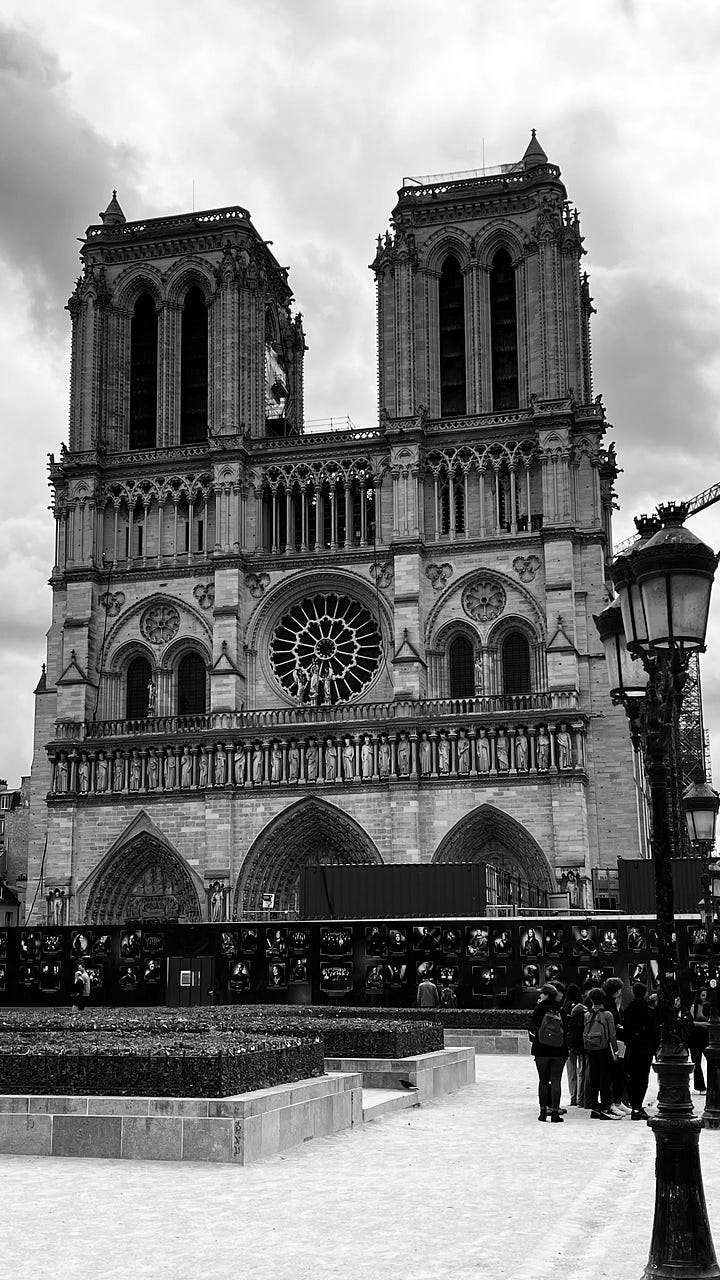

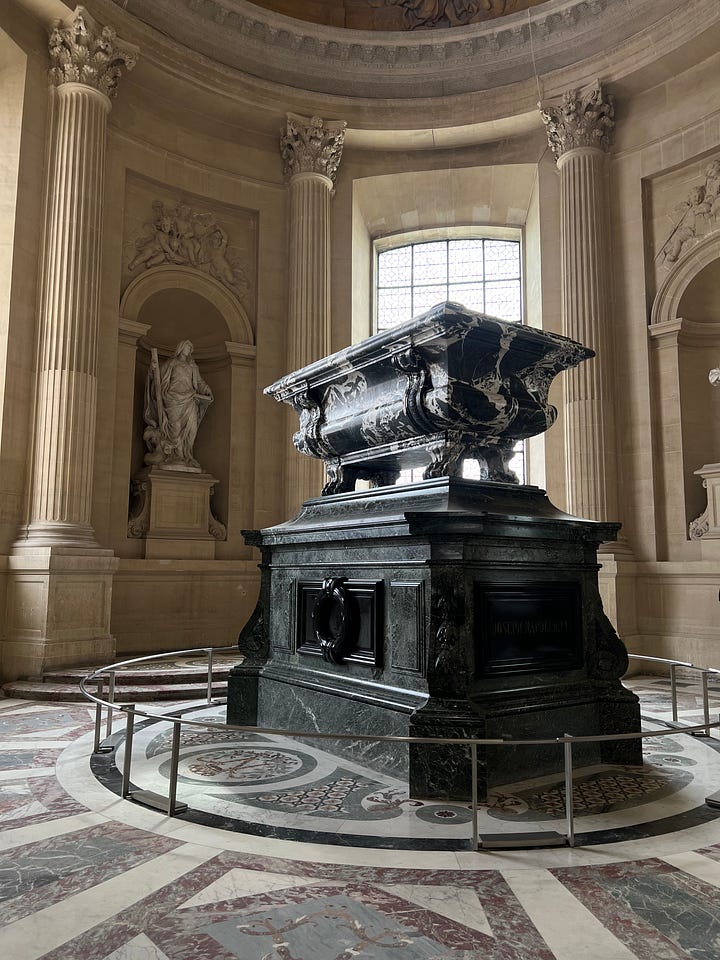

Museum-wise, there is of course the “Louvre”, and if you have time for it, “Musee d’Orsay”. Be smarter than me and give either one its own, full day. We got herded out of the Louvre like cattle when it closed at 6PM (our bad) and it was most definitely not chic. Regardless, some must-see’s for me included “Psyche revived by Cupid’s Kiss” (Room 403), “the Winged Victory” (Room 703) and Delaroche’s “the Young Martyr” (Room 701), but there is so much on display, such endless beauty to sample and savour, that I guarantee you’ll be positively overwhelmed by day’s end. Or at least I was.
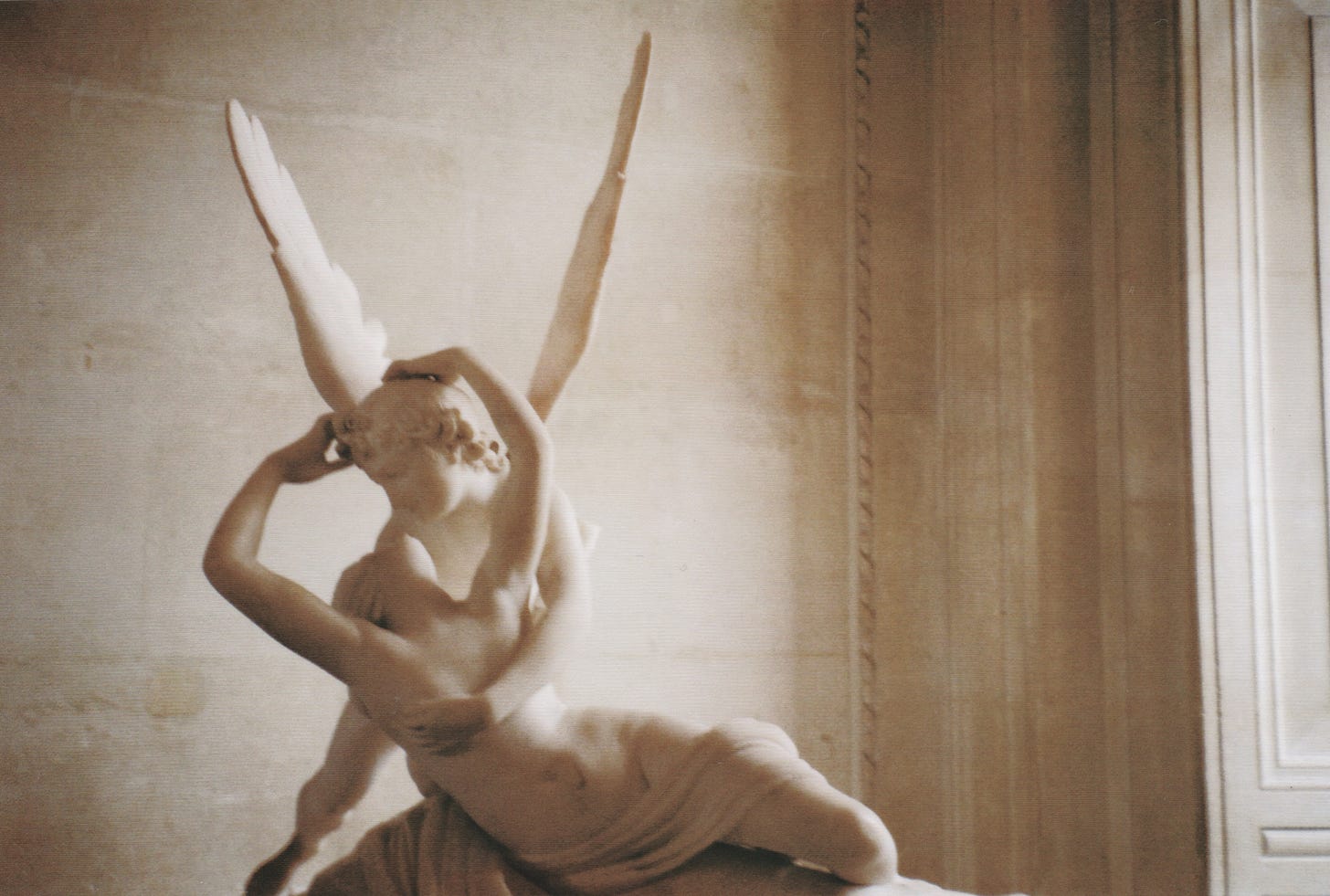
If you are more the contemporary art fiend (I know you are out there!), you might enjoy the “Pinault Collection” more. It has all the staples like Jeff Koons and Damien Hirst, and many more modern artists to flight your fancy. Very fun to discuss and argue over with your friends, even if the art itself is not entirely up your alley. I call that free entertainment! Besides, there is nothing better than people watching in a gallery like this one, trying to pin everybody down. A little controversial, perhaps, but isn’t controversy an art form in itself?
Speaking of controversy, for all you more morbidly inclined, consider adding the “Galerie de Paléontologie et d’Anatomie Comparée” to your list. It’s a gallery of bones and skulls and natural skeletons, sure to haunt. And oh my, is there a lot on offer here. The selection of wet specimen, I confess, was a bit too much for me— the brains were alright, but intestines? I don’t do those, my love. If you wish to see the specimens with feathers and whatnot still attached, try the cabinet of curiosities at “Deyrolles”. They have an endless amount of taxidermy and entomological trinkets on offer. I seriously considered taking one of their delightful stuffed crows home, but had to relinquish as stuffing it into my little suitcase would not have been a good idea. Not to speak of customs, what a buzzkill!
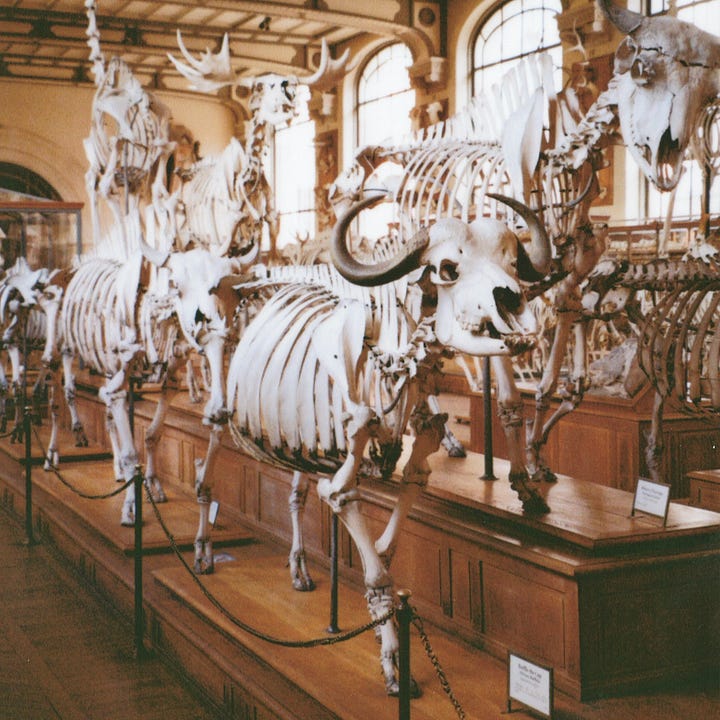

Au dernière, I knew that if I did not make it to “Père-Lachaise” cemetery, I’d never hear the end of it. Truly, I’ve lost count of the amount of times I’ve been volunteering at Highgate Cemetery right here in London only to have someone ask me if I’ve been to Père-Lachaise. Their immeasurable disappointment when I tell them I have not. So, film camera in hand and an hour or two to spare, I ventured out before my train back. It’s really a lovely Gothic-leaning cemetery, with that same Parisian philosophy of organising everything in definite quadrants, so quite easy to navigate as well, and not nearly as overgrown and labyrinthine as Highgate. But the tombs, oh, the tombs were stunning!
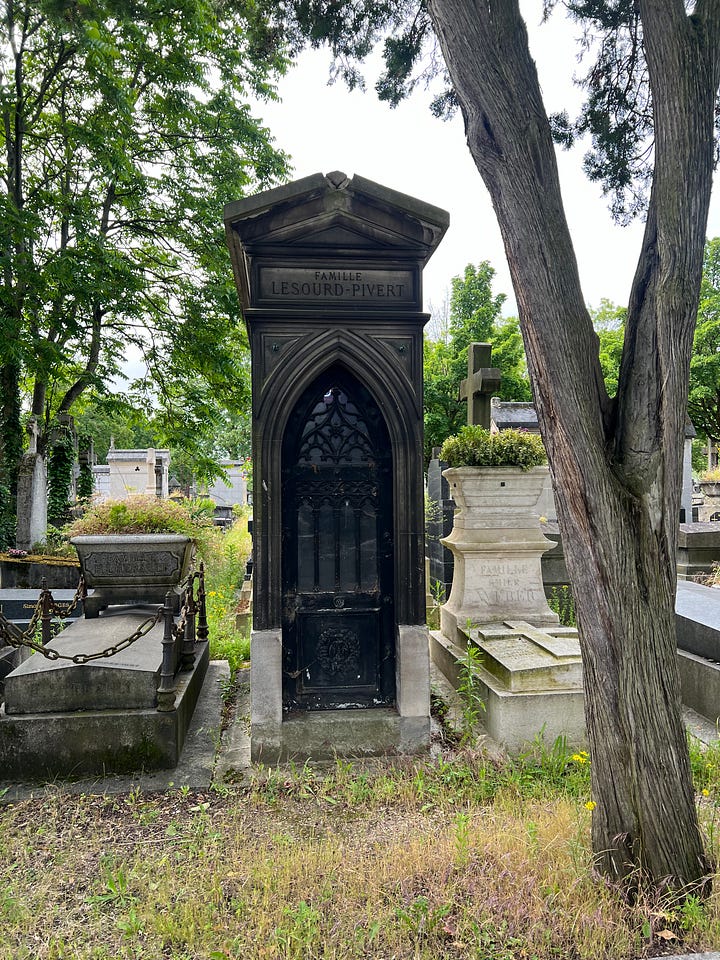
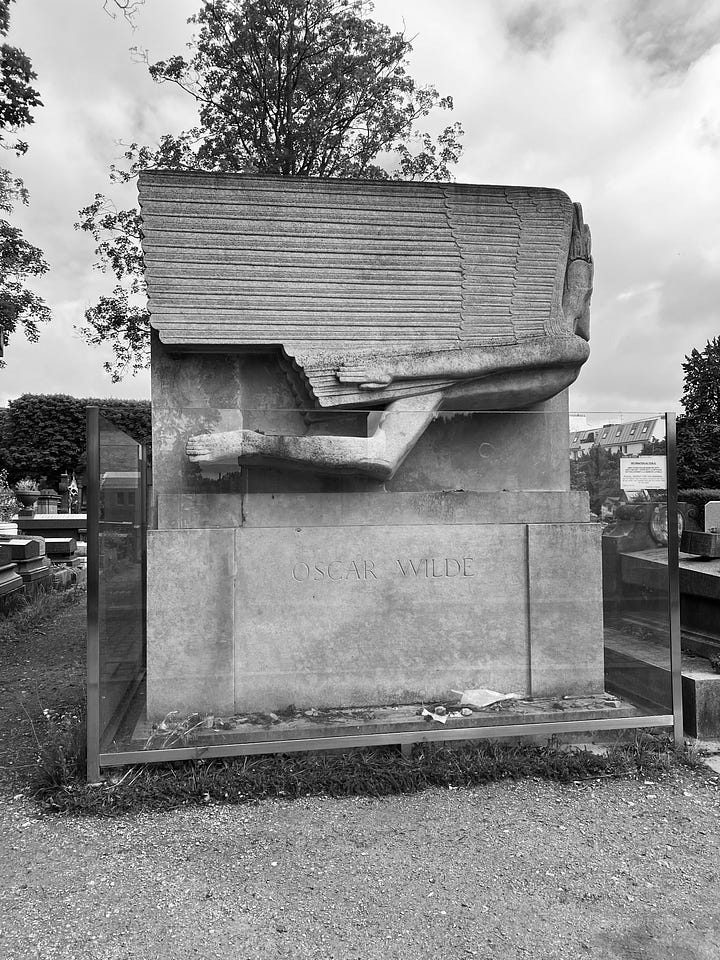
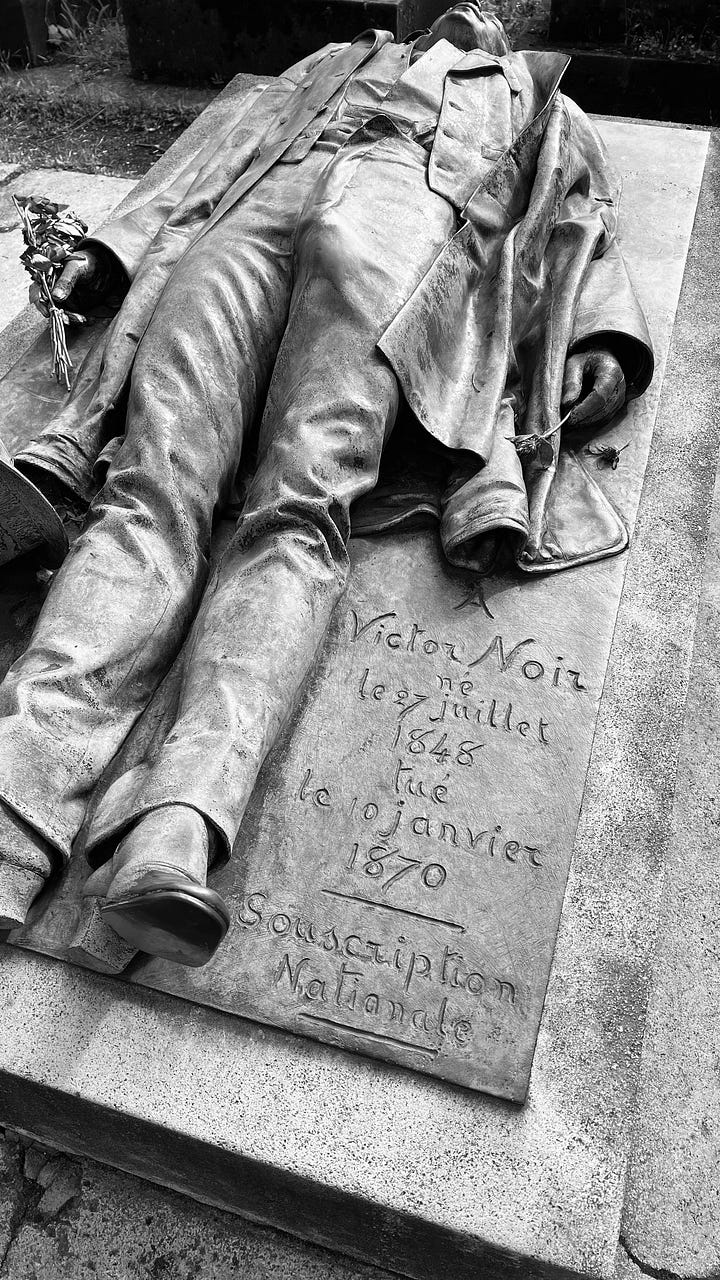
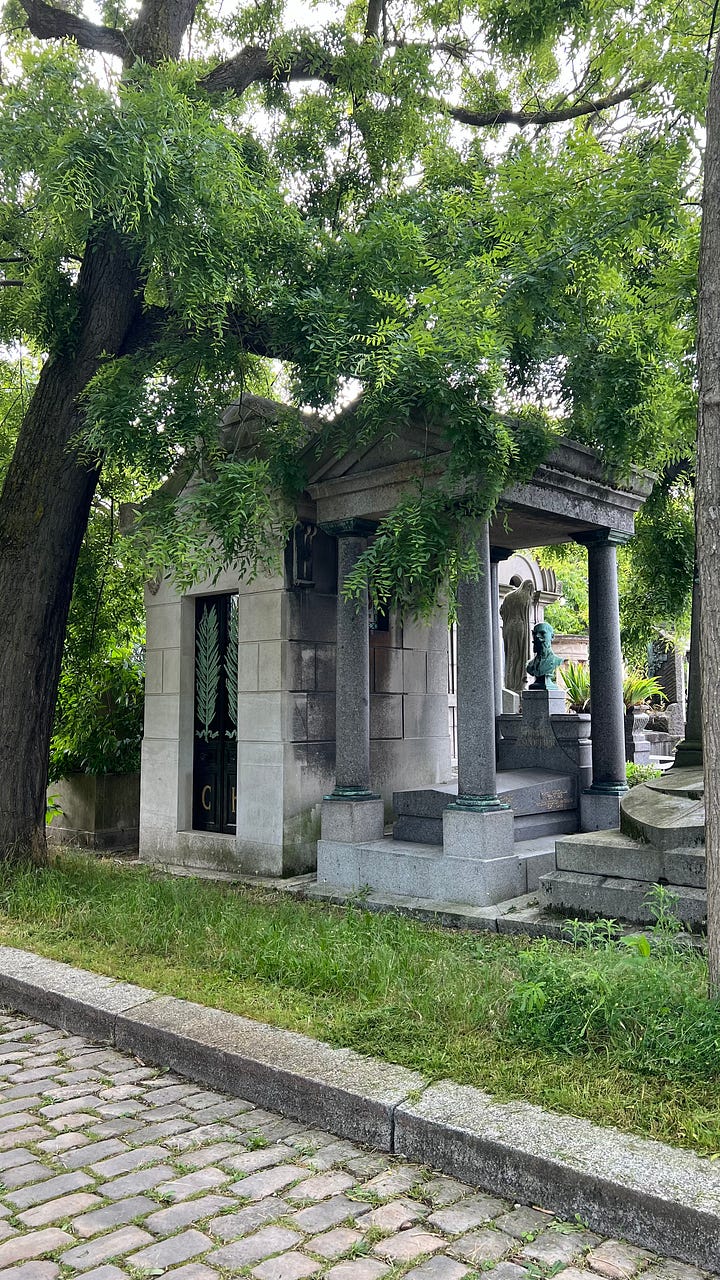
A lover of elaborate rituals and superstitions, I had come to Père-Lachaise ready to join in. My two personal must-see’s at the cemetery were:
Oscar Wilde’s grave - It used to be custom for visitors to leave a kiss mark on the stone to celebrate Wilde’s lavish and scandalous dandy philosophies, but the cemetery has now taken steps to protect the legendary writer’s grave with a clear “shield” of sorts. Better to leave the lipstick at home, seeing as all the cleaning costs for the “shield” are the family’s responsibility. Instead, may I recommend reading Wilde a poem? The more outrageous, the better. Alternatively, you could also bring a postcard or image of Wilde and give that a little smooch. Responsible, yet still very stylish.
Victor Noir’s grave4 - Not a grave known for its inhabitant, but rather for the bronze sculpture of him on top. Nobody knows what possessed its sculptor to portray Victor in this way, but the stone depicting Victor at the moment of his death has a significant… bulge of sorts in his pants. You catch my drift. Nowadays, the grave is a fertility symbol of sorts, and women from across the world flock to it to be a part in a ritual involving the stone. Legend says that if a woman leaves Victor flowers in the top hat to his side, rubs the bulge, and then gives him a kiss, it will “enhance fertility, bring a blissful sex life, or a husband within the year” (Wikipedia). Proof of the ritual’s popularity is in the pudding: the bronze around Noir’s groin and mouth is completely polished, while the rest of the bronze has oxidised to green. This of course is wonderfully odd and morbid,
so I had to partake!I still regret not giving the bust of Keats at London’s Keats House a kiss,so I was not about to miss out here. (I wish to officially retract this sentiment; see footnote 4)

For a final side note, If you, like my dad, are wondering how I always manage to find “these kinds of places” (potentially derogatory) while traveling, let me put you onto Atlas Obscura— their “places” guide has let me to the majority of my adventures, whether abroad or in the UK. They seem to aim to collect all manner of places obscure, esoteric, a little morbid, some of them well-known and some of them much less so. I could not recommend their site enough. As much as I would love to gatekeep them a little longer, I fear my need to be of use to you has won the battle. Maybe it can be our little secret. Another thing for the White Lily Society to cherish.
III. Haunted in the Alps
“Oh, I’m headed to the mountains / Where the air is sweet and new / Don’t you try to reach me 'cause I don’t want to talk to you / I’ve got some thinking to do”
by Lizzy McAlpine, from her song “To the Mountains” (2020)
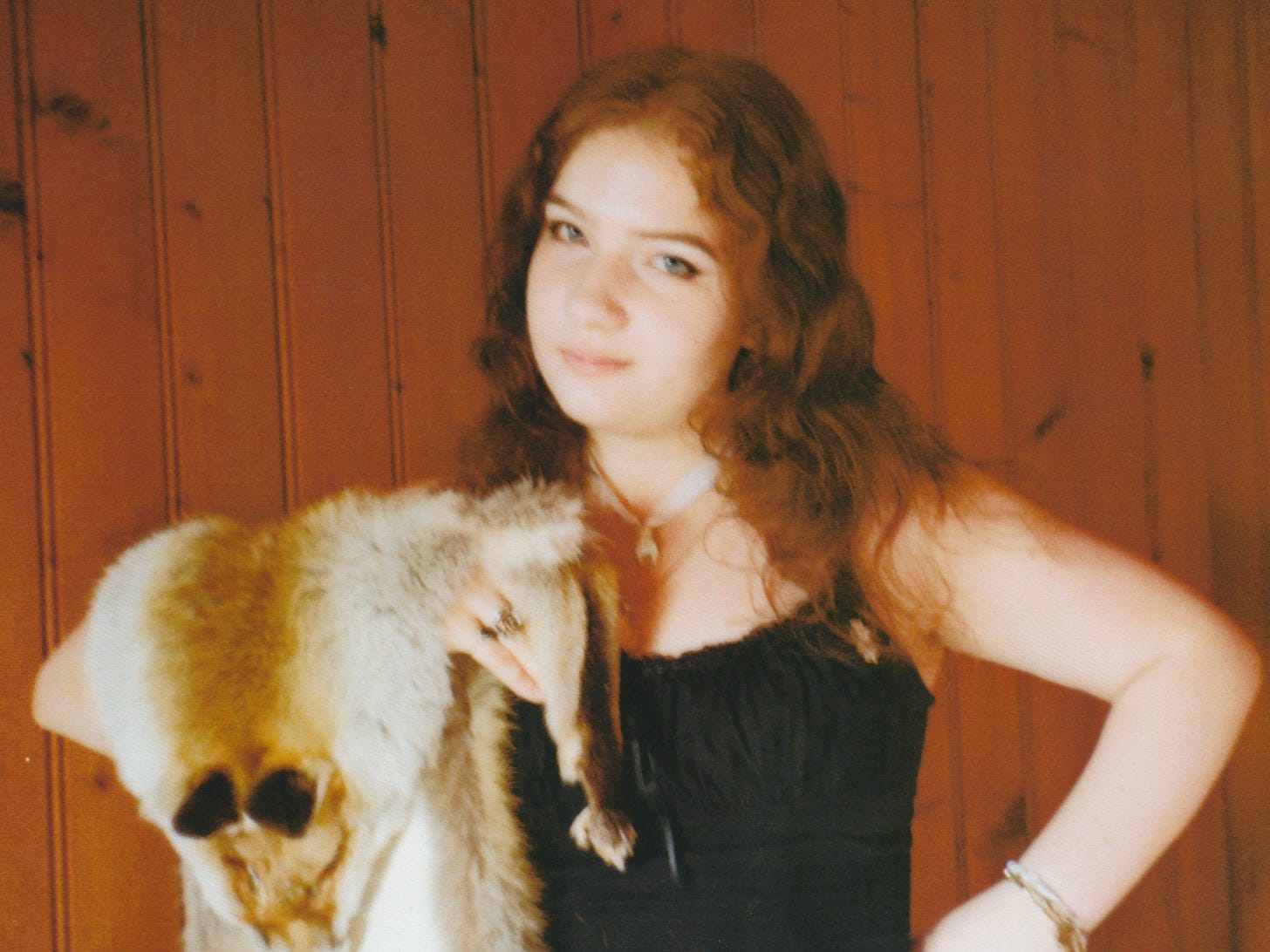
Compared to my five days manically running around Paris, my days in the Swiss Alps were a lot more meditative. I stayed with a dear friend of mine who is a little more spiritually inclined than me (I worship excess, not necessarily wellness), and we spent our time in the tall grass littered with wildflowers, doing yoga together, and giving each other tarot readings. My days were filled with cardigans, spent dramatically reclining on the sofa, and folded in between the pages of a book or two. Time moved slowly, and with a thunderstorm or two and a fire lit at dinner, my soul really got a good bit of rest, horribly repetitive as it sounds.
This does not mean the trip was devoid of excitement. On the contrary, we spent my last full day on an infernal road-trip, driving all the way around Lake Geneva in 34C heat just so I could get a glimpse of the incomparable Villa Diodati. All the suffering was worth it, in case you were wondering. And for the rare people who are out of the loop, or the people whose memories are foggy, let me recount the story of the Villa Diodati as briefly as I can (so really not briefly at all).
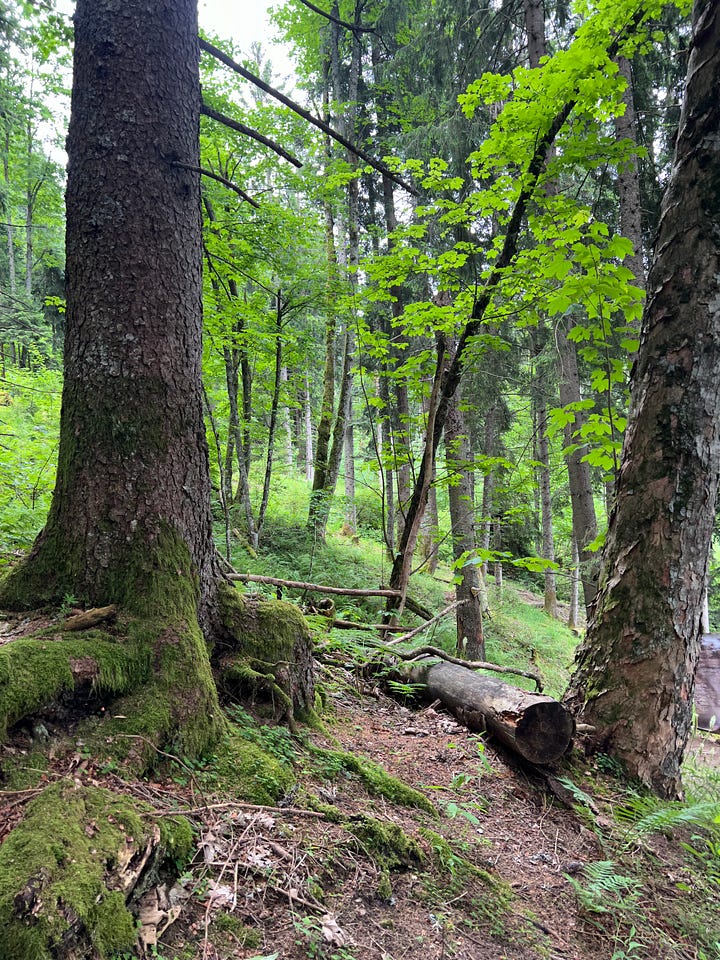

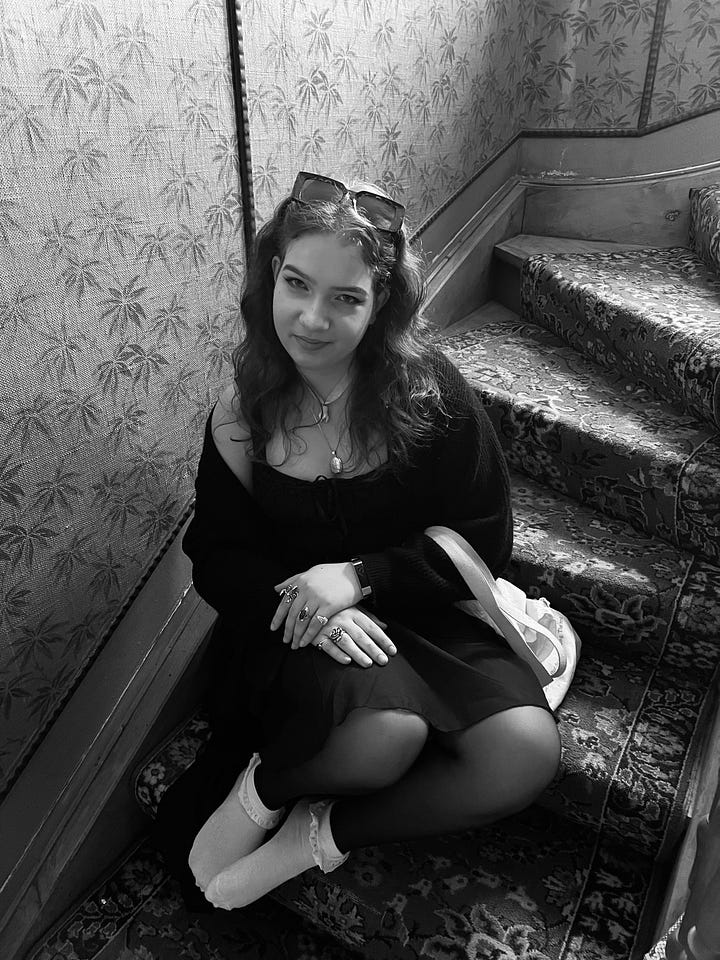

“Went to the house beyond Cologny that belonged to Diodati. They ask five-and-twenty louis for it a month. Narrow, not true. The view from his house is very fine; beautiful lake; at the bottom of the crescent is Geneva.”
Description of the Villa Diodati from dr. John Polidori’s Journals, ca. 1816, via the Pennsylvania Electronic Edition
Way back in 1815, a volcano erupted in Indonesia, and the resulting volcanic soot and ash clouds were so overwhelming that it upset global temperatures for the next three years (the so-called “Year without a Summer”). Especially Europe was struck, and the following summer in 1816 was plagued by dark days, torrential downpour, and even sometimes summer snow. This is the summer we are particularly interested in for this story, or rather this intertwining of stories. This was the very summer Lord Byron had rented himself a house by Lake Geneva, the Villa Diodati, where he was staying with his physician dr. John Polidori, who was treating him for his sleep issues at the time. But Lord Byron was by far not the only poet making his way through the world, and the days were still sun-drenched and lazy. We are setting the scene.
Elsewhere, Percy Shelley was traveling in Switzerland accompanied by his love Mary [now Shelley, then Wollstonecraft], and Claire Clairemont, half-sister to Mary and pregnant with Lord Byron’s child. Claire intended to see Byron, who she was quite infatuated with at the time, even if he was pointedly ignoring her. And ever wilful and spirited, she made it happen. Percy and Byron soon became good friends. The two traveling groups stayed in the same hotel for a bit, before each of them moved to their respective rental housing: Byron and Polidori to Diodati, and the Shelley group to a nearby little chalet named Montalègre. The walk between the two properties was only ten minutes, but soon the latter group was spending entire days Diodati, discussing literature and philosophy, and quickly being wrapped up in Byron’s usual theatrics. But soon, the weather took a sharp turn to ceaseless rainfall, as thunder flashed above and the sun blackened:
“An almost perpetual rain confines us principally to the house; but when the sun bursts forth it is with splendour and heat unknown in England. The thunder storms that visit us are grander and more terrific than I have ever seen before… one night, we enjoyed a finer storm than I had ever before beheld. […] the thunder came in frightful bursts over our head amid the darkness”
From a letter sent by Mary Shelley, taken in turn from “Young Romantics: the Shelleys, Byron and other tangled lives” (2010) by Daisy Hay
Lord Byron himself wrote a poem about the weather entitled “Darkness” (ca. 1816), writing that the inspiration was “a celebrated dark day [at Geneva], on which the fowls went to roost at noon, and the candles were lighted as at midnight". But this poem was not all the literature the Villa Diodati would inspire. One night, when the entire company was bored out of their minds and crazy with confinement, Byron suggested that they’d all try their hand at writing a ghost story to pass the time. A friendly contest, so to speak. Inspired by the atmosphere, the recent loss of her child, the previous week’s conversations about somnambulism with Polidori, galvanism, and the group’s time spent reading German ghost stories, Mary Shelley wrote what was to be the first few chapters of “Frankenstein”. Though she, of course, accredits the novel (in true Gothic fashion) to a nightmare, and not to the decades worth of ideologies and interests meeting under the perfect circumstances. Perhaps that explanation rather lacked drama for her.

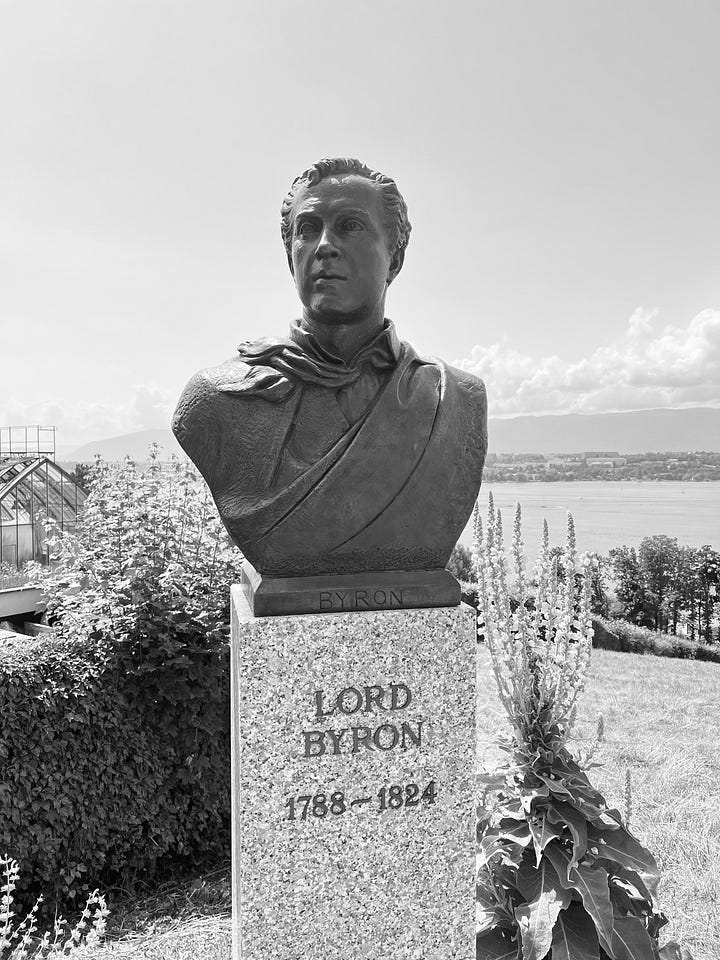
But though “Frankenstein”, as the first ever science fiction novel, gets most of the shine, it is not the only influential work produced as a result of this ghost story contest. Byron and Shelley both wrote fragments, quite quickly forgotten, and what Claire wrote, if anything at all, we don’t know, or was lost to time. But dr. John Polidori, probably sick of being belittled and pushed around by Byron for months on end (Byron annoyingly kept referring to him as “pollydolly”) wrote “the Vampyre”. A story about a dark, brooding, womanising vampire terrorising the upper classes… Most definitely a dig at Byron5. It may seem overdone now, but at the time it set the tone for a whole new generation of vampire stories. Before Polidori, vampires were often more in line with Eastern European folklore: they did not dress well or “charm” people, and they certainly didn’t do so with perfect etiquette! Polidori’s vampire was powerful, rich, and seductive— all terms now quite synonymous with the very idea of vampires.
Unfortunately, Polidori’s life does not have a happy ending. “The Vampyre” was accidentally published under Byron’s name, who despised the story, and despite it being a massive success (the masses frothed at the mouth for anything Byron, after all), the lack of recognition weighed heavily on the young doctor, who took his own life only five years after Diodati, at age twenty-five.
You can imagine what it did to me, as a certified Byron-fangirl, Romantic enthusiast, and Gothic scholar, to see the Villa, even if from a distance. The house is private property, and plenty hidden from view, so we are really talking about a glimpse here. Still, totally worth the five hours of sweaty car agony, if you ask me. Yes, I did cry a little. Promise not to tell anyone?
I truly don’t mean to ramble, my dear, and yet I somehow always do. A final honourable mention for Switzerland goes to the Chateau de Ripaille, which we visited at the tail end of our five hour, heat laden, excessively song-filled road trip— fun fact: the French term for having a feast (“faire ripaille”) actually comes from this very chateau. It was a lovely place, though the audio-tour was too saccharine for our sun-soaked grumpy minds, but I do recommend it if you happen to be in the area. That is all.
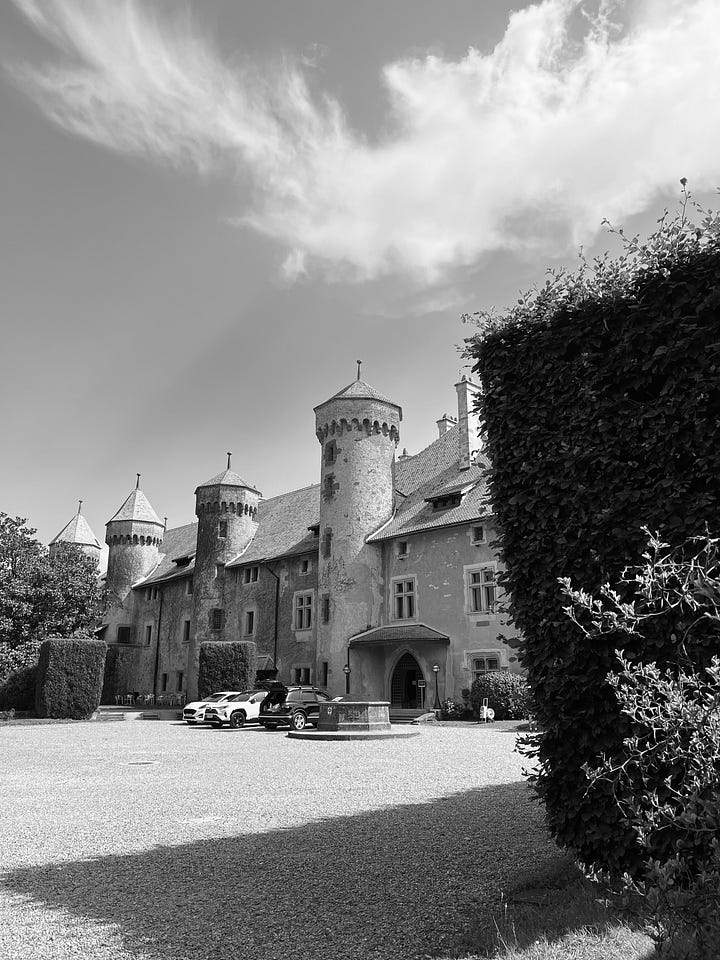
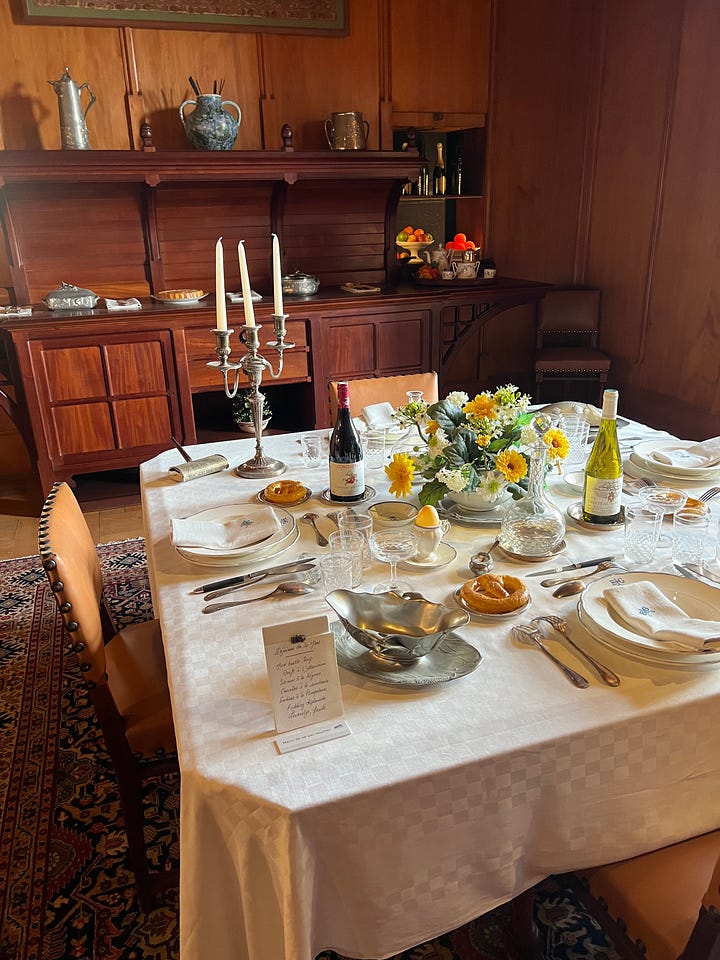
“Daydreams can be dangerous” // “Dreams do dream us, don’t they? We are not the ones in control.” // “A garden to walk in and immensity to dream in—what more could he ask? A few flowers at his feet and above him the stars.”
Triple feature quote from “Sharp Objects” (2006) by Gillian Flynn, “Gut Symmetries” (1997) by Jeanette Winterson, and “Les Misérables” (1862) by Victor Hugo


So far, so good. I’m enjoying my “Sharp Objects” summer (playlist here), reading the book by Gillian Flynn and simultaneously watching the HBO show. Accidentally going hiking in my Mary-Janes, admiring every single damn slug I see, scribbling poetry in the thick quiet before bed. Threading my ribbon-and-tooth necklace around my neck like a talisman against evil. I want to touch everything. I want to run my fingertips gently along every curve and feel every texture. Somebody told me they felt my poetry in their chest, and I saw beautiful art in Paris, and I sang with my friend as I breathed fresh mountain air, which it turns out actually does do wonders for your health. Life is good, good, good. Beautiful, beautiful, beautiful. Even if my headphones died the second I got on my train and my expensive hair oil leaked all over my toiletry bag and I for sure thought I would die getting on an airplane again for the first time in six years. It is as the great philosopher Lana del Rey sang: “We’re just beautiful people with beautiful problems”.
Until my next letter,
x Sabrina Angelina, the White Lily Society
Currently reading: “Encounters with Death: Compendium of Anthropomorphic Personifications of Death from Historical to Present Day Phenomenon” by Leilah Wendell // Most recent read: “Sharp Objects” by Gillian Flynn
White Lily Society links // Sabrina Angelina links
Subscribe for more personal ramblings but also more academia, I suppose— a win-win situation! Come, become a martyr of deliciousness. Let your inbox rejoice every month.
I attended the Sebastian Horsley showing at the Century Club in SoHo, which is open to the public now until September 15th. Go check out this dandy from the underworld’s work!
Of course, you can always submit something related to these themes after those dates, but it won’t be considered a part of our super-special-anniversary celebrations. You have been warned.
Rather embarrassingly, I was convinced this camera couldn't zoom right until I had to check the name to mention it here. Please, someone rid me of my own stupidity. I’m laughing a lot, but I’m also crying a little.
Update 03/2025: when I went, I researched beforehand and found a source saying Noir’s relatives didn’t mind the ritual, etc. That source seems to have vanished into thin air. More recent research (which I should’ve conducted this thoroughly in the first place) also revealed the cemetery had a “no indecent touching” sign put by his grave for a while. So, over time, my opinion on the ritual has soured more and more, and I’ve concluded I would much rather kiss statues of willing participants. My participation was fully under the (misplaced) guise of consent, respect, and a love for the morbid and odd. Knowing and believing what I do now, I wouldn’t do it again.
It is worth noting that there are still scholars who believe it is not a dig at Byron, but I have chosen not to entertain this idea because I find it more unlikely to think it is not a dig at Byron and Polidori accidentally let his main character be a douchebag with all of Byron’s traits. Call it a character flaw.







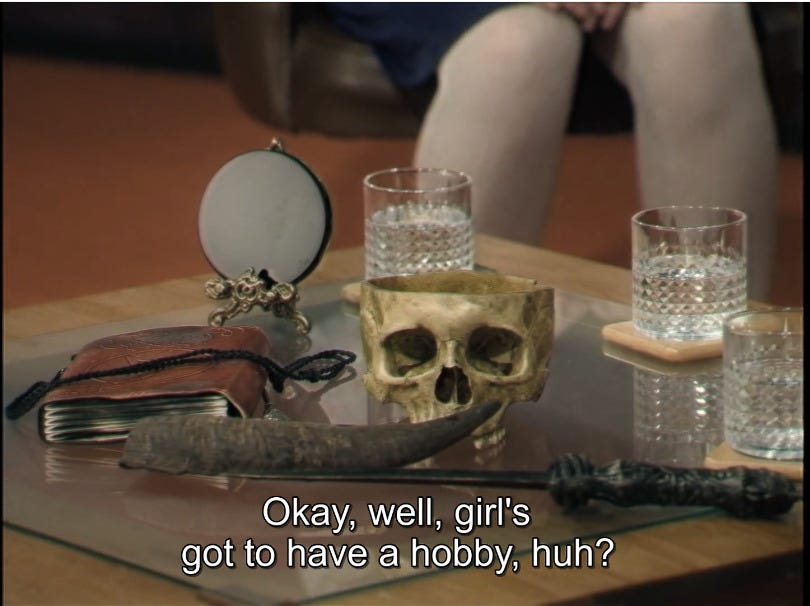

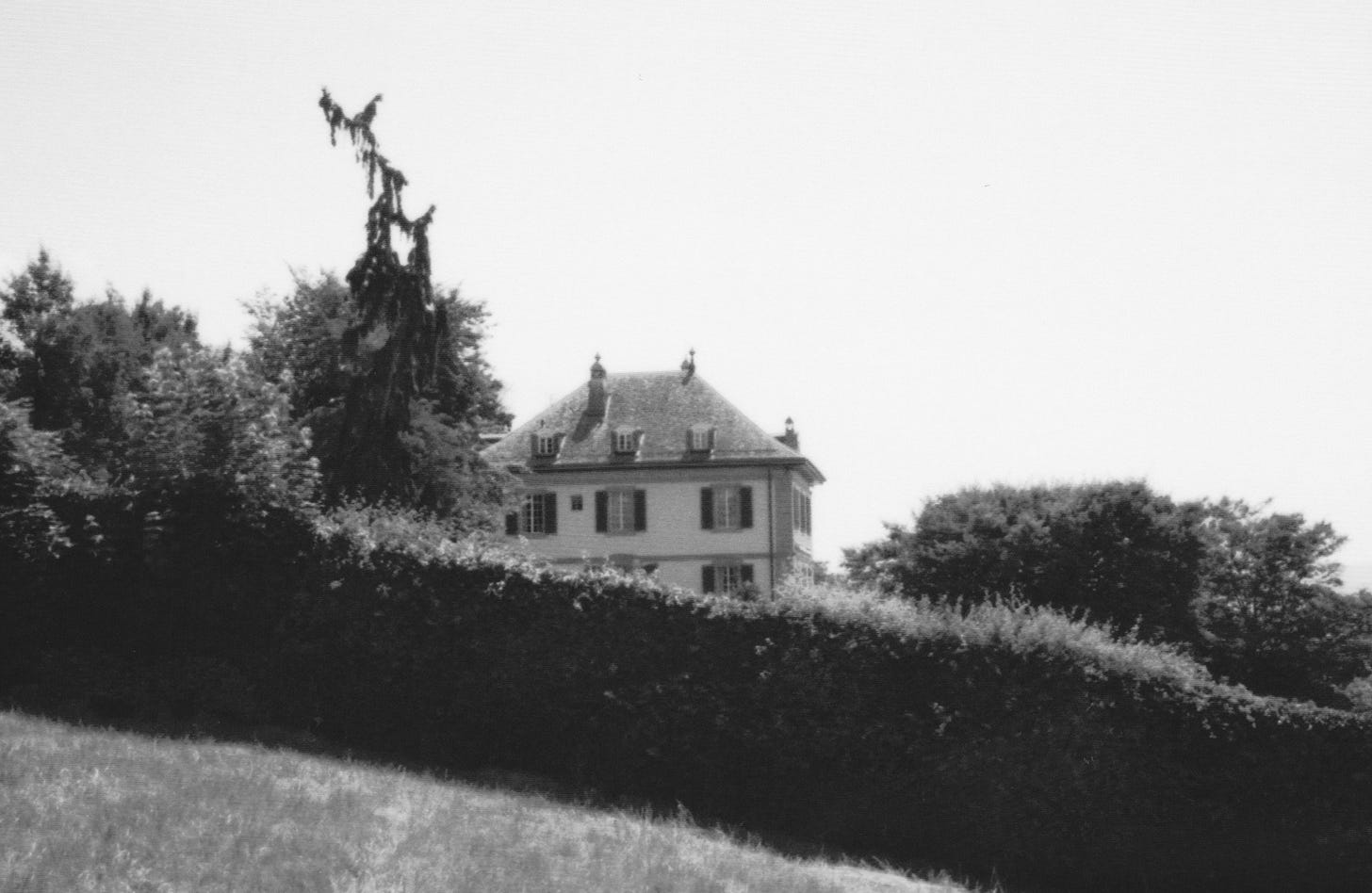

truly in awe of the way you articulate yourself